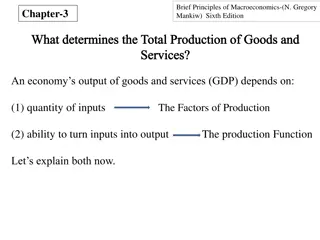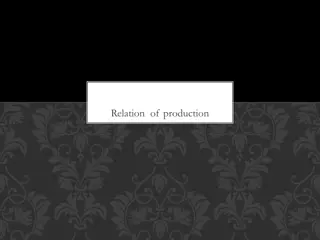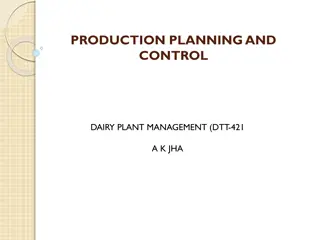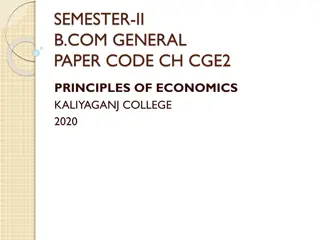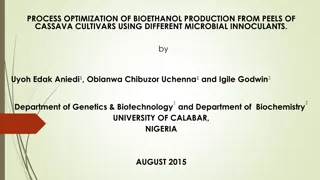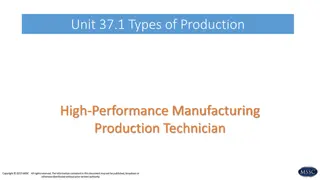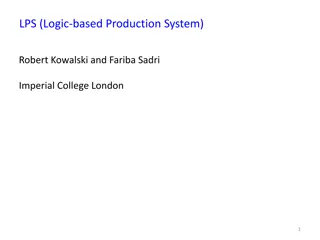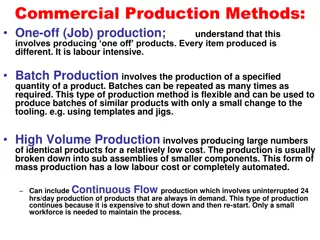Understanding Production Systems and Processes
Production involves converting resources into goods or services efficiently to meet market demands. It encompasses manufacturing, mining, growing goods, and employing processes to transform inputs into outputs. A production system comprises inputs, conversion processes, and outputs to deliver finished products effectively.
Download Presentation

Please find below an Image/Link to download the presentation.
The content on the website is provided AS IS for your information and personal use only. It may not be sold, licensed, or shared on other websites without obtaining consent from the author. Download presentation by click this link. If you encounter any issues during the download, it is possible that the publisher has removed the file from their server.
E N D
Presentation Transcript
PRODUCTION SYSTEM Rashmi P. Khobragade
Introduction Production is the process of converting resources into products or services. It is usually measured in terms of output per time period (e.g. boxes per hour, tones per day, bookings per month) or cost per unit of output (e.g. $10 per box, $20 per ton, etc). The objective of production operations is to meet the forecasted needs of the market in which they perform at the lowest possible cost.
Meaning of production Production can be explained as an act of either manufacturing or mining or growing of goods (commodities) generally in bulk for trade. Production is a method employed for making or providing essential goods and services for consumers. It is a process that puts intangible inputs like ideas, creativity, research, knowledge, wisdom, etc. in use or action. It is a way that transforms (convert) tangible inputs like raw-materials, semi- finished goods and unassembled goods into finished goods or commodities.
Meaning of system System is an arrangement or assembly of inter- dependent processes (activities) that are based on some logic and function. It operates as a whole and is designed (build) with an intension to achieve (fulfill) some objective or do some work. Huge systems are often a collection (assembly) of smaller sub-systems.
Definition of production system Production system may be defined as, "The methods, procedure or arrangement which includes all functions required to accumulate (gather) the inputs, process or reprocess the inputs, marketable output (goods)." and deliver the Production system utilizes materials, funds, infrastructure, and labour to produce the required output in form of goods.
Meaning of production system Production system consists of three main components viz., Inputs, Conversion Process and Output. Inputs include raw-materials, machines, man-hours, components or parts, drawing, instructions and other paper works.
Conversion process includes operations (actual production process). Operations may be either manual or mechanical or chemical. Operations convert inputs into output. Conversion process also includes supporting activities, which help the process of conversion. The include; Production planning and control, purchase of raw-materials, receipt, storage and issue of materials, inspection of parts and work-in-progress, testing of products, quality control, warehousing of finished products, etc. Output includes finished products, finished goods (parts), and services. supporting activities
The three components of a production system are depicted in this diagram.
Examples Tangible goods : Consider an example of a manufacturing industry like a Sugar Industry. Here, sugarcane is first used as an input, then the juice of sugarcane is processed through a conversion process, finally to get an output known as a refined sugar (used for mass consumption). Intangible goods : Consider an example from a service industry that of a software-development firm or company. Here, initially, written program codes are used as an inputs. These codes are then integrated in some database and are provided with a user-friendly interface through a conversion process. Finally, an output is made available in form of an executable application program.
Productivity Productivity describes various measures of the efficiency of production. A productivity measure is expressed as the ratio of output to inputs used in a production process, i.e. output per unit of input. Productivity is an index that measures output (goods and services) relative to the input (capital, labor, materials, energy, and other resources) used to produce them.
PRODUCTIVITY = OUTPUTS / INPUTS
Productivity Productivity is simply a measure of the ratio between the output of a process and the input of resources needed for it. It is usually expressed as output divided by input. Output can be expressed in terms of units or volume (e.g. tones, liters, boxes, etc) and these units have usually been already determined for production planning purposes. In cases where outputs cannot be individually defined a monetary total can be used (e.g. $s of production, $s of sales, etc). Inputs are usually separated into Manpower, Machinery and Materials. In cases where inputs cannot be segregated a monetary value can be substituted (e.g. s of material).
Why Productivity Matters High productivity is linked to higher standards of living As an economy replaces manufacturing jobs with lower productivity service jobs, it is more difficult to maintain high standards of living. Higher productivity relative to the competition leads to competitive marketplace Pricing and profit effects For an industry, high relative productivity makes it less likely it will be supplanted by foreign industry advantage in the
Examples of Partial Productivity Measures Units of output per labor hour Units of output per shift Value-added per labor hour Labor Productivity Machine Productivity Units of output per machine hour machine hour Capital Productivity Units of output per dollar input Dollar value of output per dollar input Energy Productivity Units of output per kilowatt-hour Dollar value of output per kilowatt- hour
Productivity Growth Productivity Growth is a key factor in a country s rate of inflation and the standard of living of its people
Productivity improves when firms: Become more efficient Downsize Expand Retrench Achieve breakthroughs
Ways to Increase Productivity Increase output by using the same or a lesser amount of (input) resource. Reduce amount of (input) resource used while keeping output constant or increasing it. Use more resource as long as output increases at a greater rate. Decrease output as long as resource use decreases at a greater rate. Production is concerned with the activity of producing goods and services. Productivity is concerned with the efficiency and effectiveness with which these goods and services are produced.






